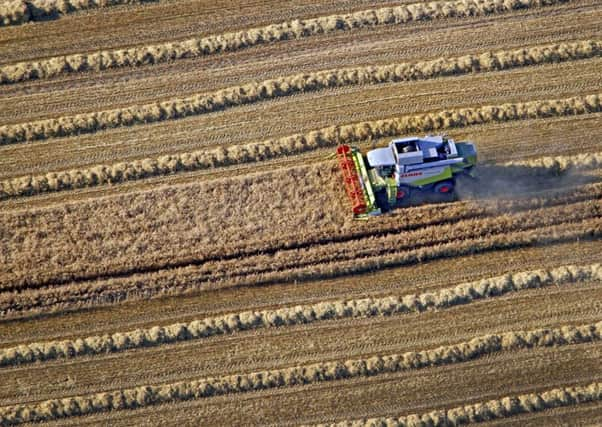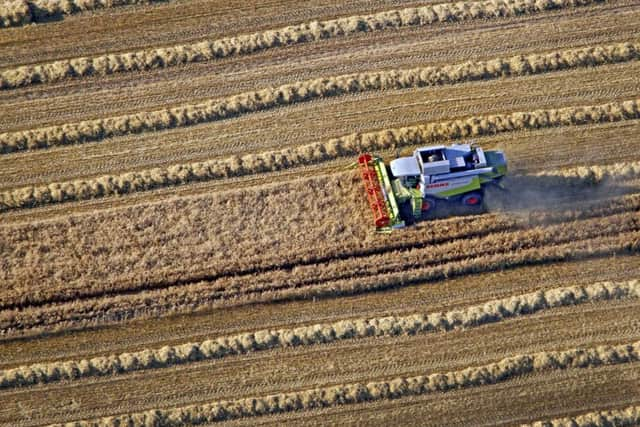Combines halted by one of Scotland's wettest summers ever
This article contains affiliate links. We may earn a small commission on items purchased through this article, but that does not affect our editorial judgement.


And when NFU Scotland’s combinable crops committee came together earlier this week, the poor weather which was halting combining was, inevitably, the main talking point.
• READ MORE: Farming news
With a few exceptions, growers the length and breadth of the country reported that what has been confirmed as the fifth wettest summer since records began had brought with it a mixed bag for Scotland’s arable farmers.
Advertisement
Hide AdAdvertisement
Hide Ad

Lothian and Borders regional chairman Kelvin Pate said that a tour of his area had shown that while major inroads had been made in lower lying areas, in hillier areas above 300 feet the stop/start nature of the harvest meant that there were a lot of fields with end rigs cut or half fields cut.
Neil White, East Berwickshire, said it had been a long stop/start, difficult job with barley, oats, wheat and beans still to cut.
“Straw has been very difficult to get with lots of straw still lying awaiting drier weather which doesn’t look like arriving,” he said.
“A lot of straw has been chopped to help clear fields for following crops.”


White added that the weather meant the costs of drying crops had risen significantly – but many were taking this as the preferred option over crop loss.
He said that while grain gathered in had been good, the continued delays were now compromising the sowing of next year’s crops.
Close to Duns, Alistair Hodge said the harvest in the Merse of Berwickshire was well through, with reasonable yields. While some crops – including oats – remained to be cut he, too, expressed frustration at the weather hampering efforts to sow next year’s crops.
Advertisement
Hide AdAdvertisement
Hide AdIn East Lothian, James Logan summed the harvest up as “frustrating” with rain most days meaning that there had never been a good run at the harvest.
From the same area, Willie Thomson, said that things had been at a standstill for about ten days, with only very short, sporadic periods available for combining.
In the North-east, many were reported to have been struggling to get spring barley cut on time, with uneven ripening and delayed harvesting spoiling what had started off as a good harvest.
In the south-west, however many growers said they were beginning to fear that without a turn-round in the weather soon, harvest – which had been at a standstill for weeks – was set to become a salvage job.
Vigilance still needed despite flu-free status
It was announced yesterday that the UK had met international requirements to declare itself free from Avian Influenza (AI) H5N8 – but all poultry keepers were urged to remain vigilant for any signs of the disease.
While the news represented an important milestone towards re-opening export markets, Scotland’s chief veterinary officer, Sheila Voas, said: “This will be welcome news for the Scottish avian industry, especially businesses which trade internationally. But this achievement does not mean that we can be complacent; the risk of avian influenza has not disappeared.”
Voas said it was essential that bird keepers maintained effective biosecurity measures as there was a constant risk of avian influenza from wild birds.
Advertisement
Hide AdAdvertisement
Hide Ad“This risk is likely to increase as winter approaches, so I would strongly urge all bird keepers to ensure that they are not only maintaining good levels of biosecurity, but have developed or updated a contingency plan for their premises or business.”
• READ MORE: Warning over risk of new strain of avian influenza
Pointing out that the disease continued to circulate in Europe, she said the risk of migratory wild birds which came to our shores in the winter increased the risks of domestic poultry being infected.
Between December 2016 and June 2017, 13 cases of AI were confirmed in kept poultry in the UK, with H5N8 avian flu confirmed at commercial premises in Suffolk, Lancashire and Lincolnshire, and in backyard flocks in Northumberland, Lancashire, Norfolk, North Yorkshire and Carmarthenshire.
The same strain of the virus was also found in wild birds in England, Scotland, Wales and Northern Ireland.